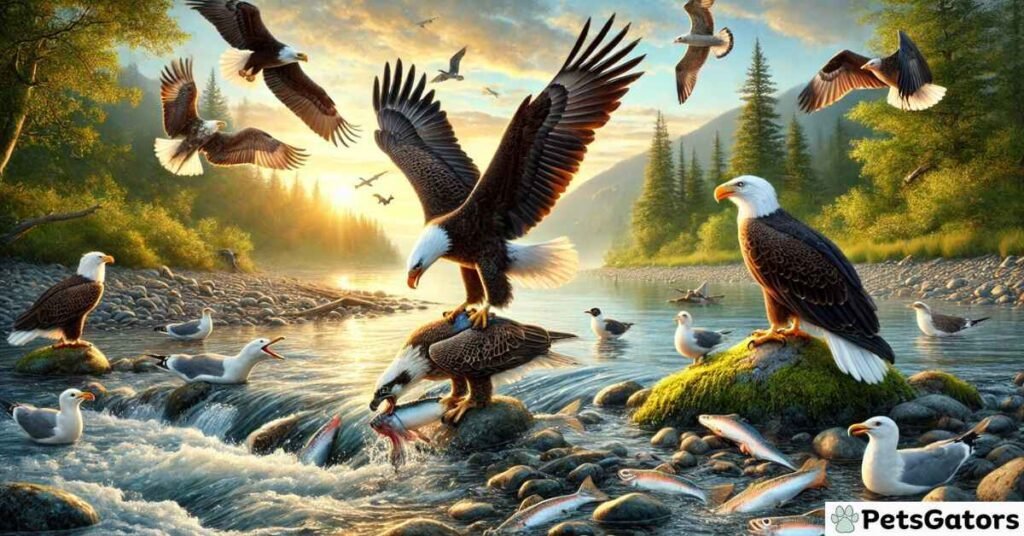Introduction
There are so many throughout the world that these fish become the principal food resource for various avian species in different parts of the world. Bald eagles, ospreys, herons, seagulls, kingfishers, and cormorants are a few of them that feast on salmon. These birds use various methods to hunt scavenge or dive for salmon, which are extremely plentiful and easily attainable during spawning seasons.
Which Birds Eat Salmon?
Such birds, usually piscivorous, have evolved to derive food sources from different species of fish, including salmon. Salmon, being rich in nutrients and being found in rivers and coastal areas, is also one of the critical food items for many birds.
The following examples explain some of the different bird species known to eat salmon, most importantly focusing on those that play a significant role in the great ecosystem, like murre, Caspian tern, and double-crested cormorant.
1. Murres
Murres are seabirds that are capable of consuming numerous fishes, including young salmon. These birds dive into deep waters, and there, they can catch their prey. Murres propel themselves under the water by their wings and hunt small fishes, including juvenile salmon.
Nevertheless, they do not only eat the smaller fishes; these birds can also be opportunistic eaters of salmon whenever it becomes available, especially during times that coincide with the movement of juvenile salmon from one area to another.
2. Caspian Terns
Caspian terns are, indeed, very effective predators of fish, especially young salmon and steelhead in the Columbia River. They easily stand out owing to their very large size and the red bill. Caspian terns hunt, hovering above the water and then swooping down for a deep plunge, to snatch fish, including young salmon.
Their presence in important salmon habitats has subsequently rendered them a natural factor in the regulation of juvenile salmon populations, although they may also affect the survival rates of young salmon as they develop.
3. Double-Crested Cormorants
The cormorant is one such bird that proves vital a player in the predation of juvenile salmon and steelhead in the Columbia River. Cormorants are powerful swimmers and divers that can dive deep into the water to catch fish using sharp hooked bills.
Big colonies of birds create a huge suicidal impact on the population of salmon. Generally, cormorants are found either along the coasts or on large water bodies, but quite often, they can be found in areas where salmon once thrived.
4. Great Blue Herons
The Great blue heron areng the largest, será majestic bird with long legs long necks, and sharp beaks that are very useful when it comes to starfishes. These bird species are piscivorous and have a hunting style that includes a variety of kinds of fish, like salmon.
Their patience and flawless targeting are highly visible in this hunting type since they hold themselves still at times, waiting for a salmon to come within reach. Hence, these birds do not consume fish in very large quantities but manage beare very good predators of juvenile salmon. Their hunting skill ensures that they become one of the important predators of juvenile salmon usually found in estuarine environments where salmon enter rivers to spawn.
5. Gulls
Gulls are opportunistic birds adapted to taking food from a variety of sources. Most species of gulls are piscivorous, but they are not above taking advantage of a salmon, especially young fish or those in difficulty, during their spawning run in rivers.
Gulls often patrol large schools of fish or circle fishing boats and commercial salmon runs. Although they generally target the weaker or injured salmon, these opportunistic birds can impact some local fish populations.
6. Loons
Loons are mostly recognized as the notable birds of North America, well-identified from the rest of the avian world by their characteristic black-and-white plumage and haunting calls. Loon is an expert diver and swimmer who dives down to great depths below the surface to catch fish.
Their diet mainly consists of fish, particularly salmon, which they hunt in lakes, rivers, and coastal waters. Loons have great expertise in capturing larger fish, which makes them one of the best predators of salmon in their entire range. Their largeness and power of beaks do indeed allow loons to catch and eat fish such as salmon in clearly visible waters.
Read Previous – Do parrots eat Brazilian nut trees
7. Grebes
Grebes are found, much like loons, as excellent swimmers and divers often in fresh lakes, rivers, and marshes. The birds consume fish as their exclusive diet, such as salmon. Grebes are known to catch fish by diving underwater.
Their diet includes juvenile salmon as well, but this is rare. While they are particularly good at capturing small fish, they also have been known to capture young salmon, making them a notable predator of these fishes when they are young.
8. Kingfishers
Kingfishers These are birds that specialize in catching fish that fall into the range of small to medium-sized types; these can even be salmon. They have powerful bills and keen eyesight that help depend on surface observation to see fish under the water, dive rapidly into the water, and take the prey-they may be able to find a juvenile salmon.
Kingfishers will hunt mostly small fish which are common at rivers and streams where the small salmons may be found.
9. American Dippers
American Dippers, or water ouzels, are fishes that find their abode in the rapidly moving water of streams and rivers. Readers might want to know more about how these birds catch fish, typically salmon fish, underwater, and they could dive into these rushing waters.
The American dipper does not easily get thrown off or turned around in turbulent waters. One thing such birds often hunt, among other fish species, would be juvenile salmon. Mostly, these birds always have excellent adaptations for life in rushing rivers, making them one of the major avian predators of salmon in the freshwater ecosystems of North America.
FAQ
Do seagulls eat live salmon?
Seagulls are not usually found hunting salmon alive. Rather, they scavenge dead or dying salmon during the times when salmon run. At those times, there are an abundance of fish available. They are opportunistic birds; they take advantage of the ones alone, weakened, or stranded to save energy while grabbing a meal.
Can kingfishers catch salmon?
Kingfishers can catch young salmon or small fish. Using their sharp beaks and keen vision, these birds dive into rivers or streams to snatch prey. While they primarily target smaller fish, they may catch juvenile salmon, especially in areas where salmon are abundant and easy to spot.
Do ospreys eat salmon?
Yes, fish are the main food of ospreys. Usually, it is salmon. They are such supreme hunters, with extraordinarily developed vision and possess highly elongated talons to dive and grab fish from the water. They tend to catch salmon during its migratory course or at the time of spawning, leaving pools full of fish that are more or less easy to acquire and swim a little slower, thus making the prey source excellent.
Conclusion
The diversity of the avian species that feast upon salmon is reflective of the very dynamic interconnections of the ecosystems in which they dwell. Murres, Caspian terns, and cormorants are among the dominant predatory species feeding on juvenile salmon, thereby regulating their population levels in nature.
Although these birds tend to enhance the natural equilibrium levels of salmon by predating on them, they are also evidence of some of the challenges salmon have in their entire life, ranging from being eaten by predators to human interference.
Thus an understanding of the role of birds in the life of salmon is crucial for both bird conservation and the sustainable management of salmon, ensuring that these species will continue to survive within a balanced ecosystem.
Stay connected and updated with – PetsGators.com!







